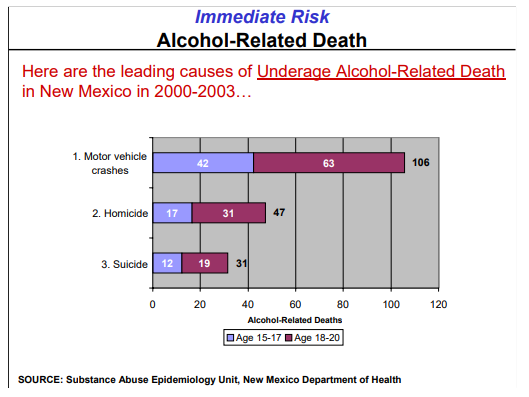The statement “Underage drinking is a problem in New Mexico” likely comes as no surprise to anyone who knows that we live in a state battling drunk driving in all age groups and have populations who experience higher-than-average rates of alcoholism. But the fact that it is not unexpected does not change the fact that we have a problem—both a civil order problem and a public health issue. And, we need to first be aware of the problem so that we can more effectively approach the individuals and agencies who have the capability to make changes that can help keep our youth safe and on the right side of the law.
New Mexico Underage Drinking Laws
Underage drinking is alcohol consumption by anyone under the age of 21. However, in New Mexico, alcohol consumption by minors is not expressly prohibited…let that sink in.
Complicating underage drinking is the fact that the law allows certain circumstances under which minors may lawfully possess alcohol and of-age adults may provide alcohol:
- In a private location
- When possessed and/or provided by a parent/guardian or spouse
Selling alcohol to minors is illegal as is providing false identification to allow minors to purchase alcohol. Using false identification to purchase alcohol is also a criminal offense.
Unfortunately, the gray area about whether it is or is not actually illegal to drink as a minor is likely a major reason why New Mexico has a higher prevalence of tweens and teens drinking and binge drinking than the rest of the country. The early age at which alcohol consumption begins and the problematic behaviors that often result lead to real-life consequences and significant economic impact.
Immediate Risks of Underage Drinking
The immediate potential consequences of underage drinking are obvious:
- Alcohol-related injuries and deaths from vehicle crashes
- Alcohol-related violence—homicides and suicides
The table* shows dated statistics from 2002-2003. These numbers have increased in the last decade, meaning more high school students and young adults are getting hurt and dying because of alcohol consumption.

Yet, these numbers only partly tell the story. When minors die prematurely because of alcohol-related events, there is a loss of potential—what they could have done, what they could have contributed had they lived to a normal life expectancy (on average about 55 years longer). There is no way to tally the cost in terms of dollars or quality of life; there is no way to know what innovations or revolutionary ideas may have been introduced to the world.
However, we can calculate what these injuries and the associated loss of productivity cost the economy:
- Alcohol-related vehicle accidents—$240.2 million per year
- Alcohol-related violence—$219.9 million per year
These costs are sometimes paid directly by the families in medical bills and lost wages because parents missed work to tend to their children or grieve their loss. Sometimes these costs are paid by taxpayers and insurance policy holders.
Still, these risks are not the only potential immediate consequences. Underage drinkers may also face DWI arrests. And, a DWI conviction can have lasting consequences that interfere with one’s ability to drive and get a job.
Long-Term Risks of Underage Drinking
If underage drinkers survive beyond 21, the problems with underage drinking are not behind them. Statistically, underage drinking is a major factor in the development of alcohol addiction as well as alcohol-related health issues as an adult.
Compared to the rest of the country, New Mexico has one of the highest rates of adult alcohol-related psychiatric disorders (alcohol dependence/abuse as defined in the DSM-IV).
New Mexico also ranks first nationwide for the most deaths from alcohol-associated disease (e.g. liver disease, alcohol dependence syndrome).
What You Can Do about Underage Drinking
Everyone can actively participate in efforts to reduce underage drinking. Some of the ways you can contribute are common sense:
- Do not furnish alcohol to minors, even if it is lawful in your private residence or because you are a parent
- Know who your child’s peer group is and what kind of influences they may exert on your child
- Use apps (preferably with your child’s knowledge) to help monitor your child’s driving behavior and whereabouts
If you notice any signs of problem behavior, talk to your child right away. Your awareness and interest may be the most effective deterrent. If you need help identifying signs or starting a conversation, you can ask Duke City Recovery Toolbox for resources. We also provide family counseling services and can provide referrals to early intervention programs.
* Table from Roeber, J. (2005). Underage drinking in New Mexico: Overview and Highlights. p. 3. New Mexico Department of Health: Epidemiology and Response Division, Substance Abuse Epidemiology Unit.





